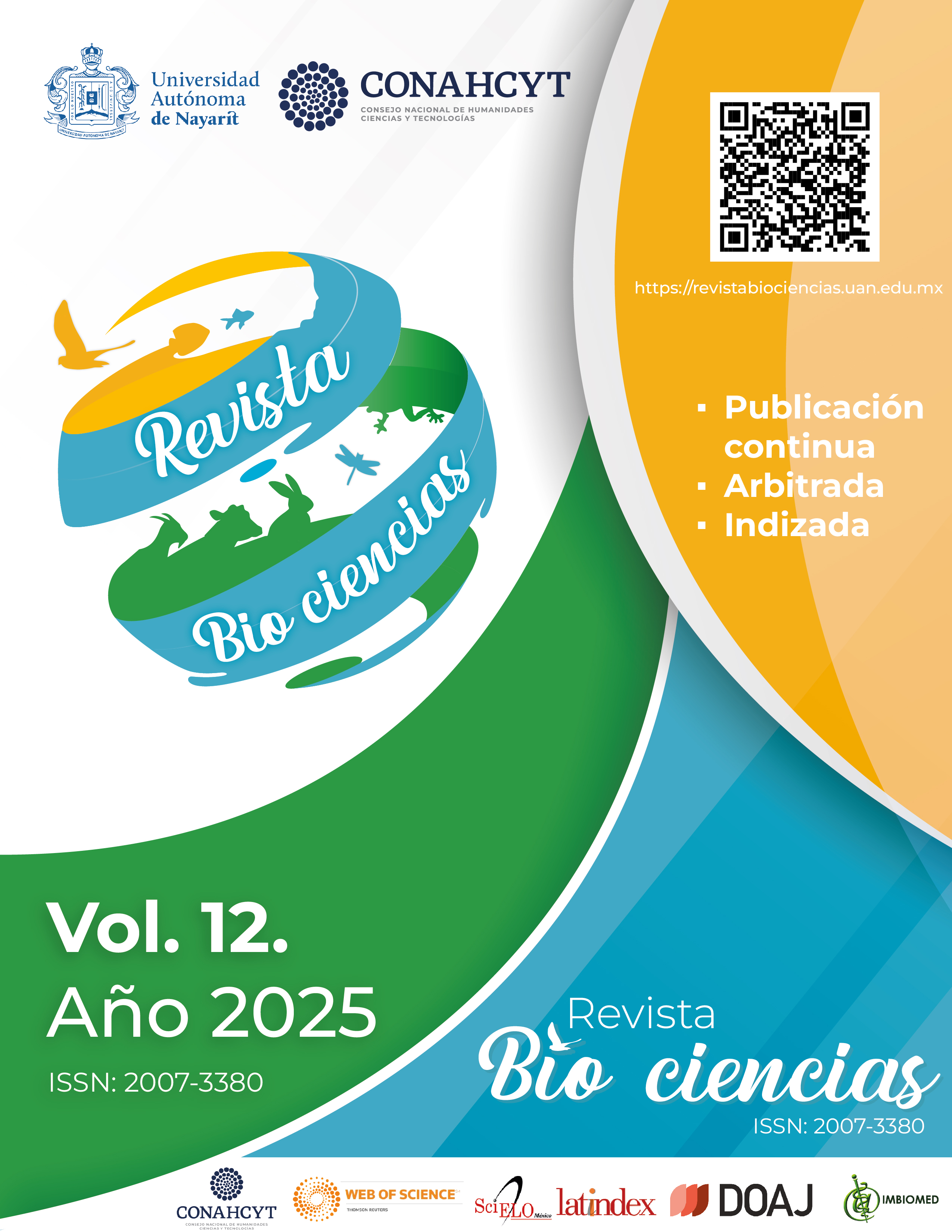Resumen
Una de las vías para enfrentar el cambio climático es el uso de genotipos adaptados como el germoplasma local de higuera, el cual posee características morfológicas y fisiológicas que le permiten reducir su consumo de agua y adaptarse a climas cálidos y áridos, además tiene propiedades nutracéuticas deseables para el mercado internacional. Así, el objetivo de esta investigación fue caracterizar colectas de higuera a nivel morfológico y medir algunos indicadores biofísicos de su adaptación al clima regional. En una primera fase de vivero, se colectaron varetas en la Región Lagunera de higueras de 25-40 años de crecimiento. Después de 90 días en vivero, se hizo la caracterizaron a nivel foliar separando variables cualitativas y cuantitativas de la hoja, las cuales fueron analizadas mediante agrupamiento y anova respectivamente. Con ello pudieron observarse tres grupos tanto en caracteres cualitativos como en los cuantitativos, habiendo una biodiversidad importante en las características morfológicas, resaltando las propiedades del látex, estomas y tricomas como mecanismos de protección al ambiente. Con base en éste análisis fue posible determinar que existe biodiversidad de higueras en la Región Lagunera con varios años de adaptación, las cuales poseen mecanismos biológicos a nivel morfológico que les permiten tolerar el clima local cálido y árido.
Citas
Almajali, D., Abdel-Ghani, A. H., & Migdadi, H. (2012). Evaluation of genetic diversity among Jordanian fig germoplasm accessions by morphological traits and ISSR markers. Scientia Horticulturae, 147, 8-19. http://dx.doi.org/10.1016/j.scienta.2012.08.029
Ammar, A., Aissa, I. B., Mars, M., & Gouiaa, M. (2020). Comparative phyisiological behavior of fig (Ficus carica L.) cultivars in response to water stress and recovery. Scienctia Horticulturae, 260 (27), 108881. https://doi.org/10.1016/j.scienta.2019.108881
Baziar, G., Jafari, M., Noori, M. S. S., & Samarfard, S. (2018). Evaluation of genetic diversity among Persian fig cultivars by morphological traits and RAPD markers. HortScience, 53(5), 613-619. https://doi.org/10.21273/HORTSCI11306-16
Ҫalişkan, O., & Polat, A. A. (2011). Phytochemical and antioxidant properties of selected fig (Ficus carica l.) accessions from Eastern Mediterranean region of Turkey. Scientia Horticulturae , 128, 473-478. https://doi.org/10.1016/j.scienta.2011.02.023
Chavez-Barrantes, N., & Gutérrez-Soto, M. A. (2017a). Respuestas al estrés por calor en los cultivos. I. Aspectos moleculares, bioquímicos y fisiológicos. Agronomía Mesoamericana, 28(1), 237-253. 10.15517/AM.V28I1.21903
Chavez-Barrantes, N., & Gutérrez-Soto, M. A. (2017b). Respuestas al estrés por calor en los cultivos. II. Tolerancia y tratamiento agronómico. Agronomía Mesoamericana, 28(1), 255-271. http://dx.doi.org/10.15517/am.v28i1.21904
Comisión Nacional para el Conocimiento y Uso de la Biodiversidad [CONABIO]. (2025). [Página de CONABIO]. (2025, Febrero 18). Explorador de cambio climático y biodiversidad. Reporte de áreas seleccionadas. CONABIO, IB-UNAM, CONANP, PNUD, INECC. http://www.biodiversidad.gob.mx/pais/cambio_climatico.html
Comisión Nacional del Agua [CONAGUA]. (2018). [Página de CONAGUA]. (2025, Marzo 25). Estadísticas del agua en México. Secretaría del Medio Ambiente y Recursos Naturales. 303 p. http://sina.conagua.gob.mx/publicaciones/EAM_2018.pdf
El Oualkadi, A., & Hajjaj, B. P. (2019). Use the biometric parameters to characterize the local fig (Ficus carica L) in Tafza area of Morocco. International Journal of Environment Agriculture and Biotechnology, 4(6), 1777-1780. 10.22161/ijeab.46.24
Fráguas, C. C., Pasqual, M., Gómez, de A., A., Pereira, A. R., & de Castro, E. M. (2012). Acclimatization and leaf anatomy of micropropagated fig plantlets. Revista Brasileira Fruticultura, 34(4), 1180-1188. https://doi.org/10.1590/S0100-29452012000400027
Gagaoua, M., Boucherba, N., Bouanane-Darenfed, A., Ziane, F., Nait-Rabah, S., Hafid K., & Boudechicha, H. R. (2014). Three-phase partitioning as an efficient method for the purification and recovery of ficin from Mediterranean fig (Ficus carica L.) latex. Separation and Purification Technology, 132, 461-467. doi: https://doi.org/10.1016/j.seppur.2014.05.050
García-Ruíz, M. T., Mendoza-Castillo, V. M., Valadez-Moctezuma, E., & Muratalla-Lúa, A. (2013). Initial assessment of natural diversity in mexican fig landraces. Genetics and Molecular Research, 12(2), 3931-39-43. http://dx.doi.org/10.4238/2013.September.23.12
Garza-Alonso, C. A., Olivares-Sáenz, E., Gutiérrez-Díez, A., Vázquez-Alvarado, R. E., & López-Jiménez ,A. (2019). Visual Symptoms, vegetative growth, and mineral concentration in fig tree (Ficus carica L.) under macronutrient deficiencies. Agronomy, 9(12), 787. https://doi.org/10.3390/agronomy9120787
Giordano, C., Maleci L., Agati,G., & Petruccelli, R. (2019). Ficus carica L. leaf anatomy: tricomes and solid inclusions. Annals of Applied Biology, 176, 47-54. doi: https://doi.org/10.1111/aab.12557
Hu, J., Li, Y., & Jeong, R. (2020). Putative silicon transporters and effect of temperature stresses and silicon supplementation on their expressions and tissue silicon content in poinsettia. Plants, 9, 569. https://doi.org/10.3390/plants9050569
Inzunza-López, J. O., López-Ariza, B., Valdez-Cepeda, R. D., Mendoza, B., Sánchez-Cohen, I., & García-Herrera, G. (2011). La variación de las temperaturas extremas en la ‘Comarca Lagunera’ y cercanías. Revista Chapingo Serie Forestales y del Ambiente, 17, 45-61. 10. 5154/r.rchscfa. 2010.09.071
IPGRI & CIHEAM. (2003). [Página del CGIAR]. (2025, Enero 15). Descriptors for fig (Ficus carica). International Plant Genetic Resources Institute, Rome, Italy, and International Centre for Advanced Mediterranean Agronomic Studies, Paris, France, ISBN 92-9043-598-4. https://cgspace.cgiar.org/items/6fc9af4b-3971-4524-a085-2bfd5cdb1321
Klimko, M., & Truchan, M. (2006). Morphological variavility of the genus Ficus L. (Moracea) and its taxonomic implications. Acta Societatis Botanicorum Poloniae, 75(4), 309-324. 10.5586/asbp.2006.038
Konno, K. (2011). Planta latex and other exudates as plant defense systems: roles of various defense chemicals and proteins contained therein. Phytochemical 72, 1510-1530. https://doi.org/10.1016/j.phytochem.2011.02.016
Liu, C., Li, Y., Xu, L., Chen, Z, & He, N. (2019). Variation in leaf morphological, stomatal, and anatomical traits and their relationships in temperate and subtropical forests. Scientific Reports, 9, 5803. https://doi.org/10.1038/s41598-019-42335-2
Magaña-Álvarez, A., Vencioneck, D. J. C., Cameiro, T., Pérez-Brito, D., Tapia-Tussel, R., Aires, V. J., Higuera-Ciapara, I., Machado Bueno, F. P., & Ribeiro, F. A. A. (2016). Physical characteristics of the leaves and the latex of papaya plants infected with the papaya meleira virus. International Journal of Molecular Sciences, 17, 574. https://doi.org/10.3390/ijms17040574
Males, J., & Griffiths, H. (2017). Stomatal biology of CAM plants. Plant Physiology, 174, 550-560. https://doi.org/10.1104/pp.17.00114
Mamoucha, S., Fokialakis, N., & Christodoulakis, N. S. (2015) Leaf structure and histochemistry of Ficus carica (Moraceae), the fig tree. Flora, 218, 24-34. https://doi.org/10.1016/j.flora.2015.11.003
Mardinata, Z., Sabli, T. E., & Ulpah, S. (2021). Biochemical responses and leaf gas Exchange of fing (Ficus carica L.) to wáter stress, short-term elevated CO2 levels and brassionolide application. Horticulturae, 7, 73. https://doi.org/10.3390/horticulturae7040073
Márquez, G. S. Y., Figueroa, V. U., Zegbe, J. A., Arreola, A. J. G., Cueto, W. J. A., & Trejo, C. R. (2020). Leaf nutrient concentrations and dry biomass of fig plants as modified by the application of NPK: a preliminary study. Asian Journal of Agricultural and horticultural Research, 7(4), 30-41. 10.9734/ajahr/2020/v7i430102
Martínez-Bastidas, T. F., Romero-Castillo, R. A., Amarillas-Bueno, L. A., López-Meyer, M., Sañudo-Barajas, J. A., Osuna-Enciso, T., Basilio-Heredia, J., Lightbourn-Rojas, L. A., & León-Félix, J. (2017). Proteínas heterotriméricas: señalización de plantas en condiciones de estrés ambiental. Revista Fitotecnia Mexicana, 40(2), 169-180. https://doi.org/10.35196/rfm.2017.2.169-180
Martínez-Macías, K. J., Márquez-Guerrero, S. Y., Martínez-Sifuentes, A. R., & Segura-Castruita, M. A. (2022). Habitat Suitability of Fig (Ficus carica L.) in Mexico under Current and Future Climates. Agriculture 2022, 12, 1816. https://doi.org/10.3390/agriculture12111816
Mawa, S., Husain, K., & Jantan, I. (2013). Ficus carica L. (Moraceae): phytochemistry, traditional uses and biological activities. Evidence-Based Complementary and Alternative Medicine, Article ID974256. https://doi.org/10.1155/2013/974256
Mendoza-Castillo, V. M., Vargas-Canales, J. M., Calderón-Zavala, G., Mendoza-Castillo, Ma. Del C., & Santacruz-Varela, A. (2017). Intensive production systems of fig (Ficus carica L.) under greenhouse conditions. Experimental Agriculture, 53, 3, 339350. https://doi.org/10.1017/S0014479716000405
Mendoza-Castillo, V. M., Pineda-Pineda, J., Vargas-Canales, J. M., & Hernández-Arguello, E. (2019). Nutrition of fig (Ficus carica L.) under hydroponic and greenhouse conditions. Journal of Plant Nutrition, 42, 11-12, 1350-1365. https://doi.org/10.1080/01904167.2019.1609510
Muñoz, A. V., Berger N. F., & Lobos, L. G. (2017). Frutales de bajo requerimiento hídrico: higuera y tuna. In: Lobos L G., Veas V A., Balbontín N. C. Muñoz A. V., Franck B. N. & Portillas S. A. Manejo hídrico de frutales bajo condiciones edafoclimáticas de Limarí y Choapa. Instituto de Investigaciones Agropecuarias. Coquimbo, Chile. (pp. 41-58). Ed. INIA INTIHUASI. https://bibliotecadigital.ciren.cl/items/2485f0d0-ef81-4898-9aae-91aacbe46ae4
Niechayev, A. A., Jones, A. M., Rosenthal, D. M., & Davis, S. C. (2019). A model of environmental limitations on production of Agave Americana L. grown as a biofuel crop in semi-arid regions. Journal of Experimental Botany 70(22), 6549-6559. doi: https://doi.org/10.1093/jxb/ery383
Nigam, A. (2007). Lab manual in biochemistry immunology and biotechnology. Ed. Tata McGraw-Hill Education.
Ogunkule, A. T. J., & Oladele, F. A. (2008). Leaf epidermal studies in some Nigerian species of Ficus L. (Moraceae). Plant Systematics and Evolution, 274, 209-221. https://doi.org/10.1007/s00606-008-0044-9
Pacheco, R. G. E., & Arenas, R. H. (2017). Diversificación de mercados: estrategia para el sector agroalimentario. In: Oportunidades de exportación ante la creciente demanda mundial de alimentos. Claridades Agropecuarias, 276, 11-19. https://info.aserca.gob.mx/claridades/marcos.asp?numero=276
Pierantoni, M., Tenne, R., Rephael, B., Brumfeld, V., van Casteren, A., Kupczik, K., Oron, D., Addadi, L., & Weiner, S. (2018). Mineral deposits in Ficus leaves: morphologies and locations in relation to function. Plant Physiology, 176, 1751-1763. https://doi.org/10.1104/pp.17.01516
Podgornik, M., Vuk, I., Vrhovnik, I., & Mavsar, D. B. (2010). A survey and morphological evaluation of fig (Ficus carica L.) genetic resources from Slovenia. Scientia Horticulturae, 125, 380-389. https://doi.org/10.1016/j.scienta.2010.04.030
SAS Institute Inc. (2002-2010). SAS/STAT para Windows (Versión 9.3) [Software]. SAS. https://www.sas.com/es_mx/software/stat.html
Servicio Meteorológico Nacional [SMN]. (2022). [Página de CONAGUA]. (2022, Abril 7). Normales climatológicas por estado. Histórico para Durango 1951-2010. CONAGUA. https://smn.conagua.gob.mx/es/informacion-climatologica-por-estado?estado=dgo
SIAP-SADER. (2025). [Página de SIAP-SADER]. (2025, Febrero 20). Producción agrícola. Cierre de la producción agrícola 1980-2023. SIAP-SADER. https://nube.siap.gob.mx/cierreagricola/
SMN-CONAGUA. (2024). [Página de CONAGUA]. (2024, Abril 7). Base de datos climatológicos 1980-2020. Estaciones Francisco I. Madero (5180) y Cartagena (10168). CONAGUA. https://smn.conagua.gob.mx/es/climatologia/informacion-climatologica/informacion-estadistica-climatologica
Sosnovsky, Y. (2015). Microscopical investigation of the laf architecture in greenhouse cultivated Ficus (Moraceae). Plant Systematics and Evolution, 301, 1669-1692. https://doi.org/10.1007/s00606-014-1184-8
The R Fundation for statistical Computing Platform. (2021). R (Versión 4.1.0.) [Software]. The R Project for Statistical Computing. https://www.r-project.org/
Upadhyay R. K. (2013). Effects of plant latex based anti-termite formulations on indian white termite Odontotermes abesus (Isoptera: odontotermitidae) in sub-tropical high infestation áreas Open Journal of Animal Science, 3(4), 281-294. http://dx.doi.org/10.4236/ojas.2013.34042
Urano, D., & Jones, A. M. (2014). Heterotrimeric G protein-coupled signaling in plants. Annual Review of Plant Biology, 65, 365-384. 10.1146/annurev-arplant-050213-040133
Villanueva, D. J., Cerano, P. J., Estrada, Á. J., Morán, M. R., & Constante, G. V. (2019). Precipitación y gasto reconstruido en la cuenca baja del río nazas. Revista Mexicana De Ciencias Forestales, 1(1), 25–37. https://doi.org/10.29298/rmcf.v1i1.650
Wilcox, D., Dove, B., McDavid, D., & Greer, D. (2002). UTHSCSA ImageTool for Windows (Versión 3.0) [Software]. UTHSCSA ImageTool.
Zhang, Y., Wan ,Y., Huo, B., Li, B., Jin, Y., & Hu, X. (2018). Extracts and components of Ficus carica leaves suppress survival, cell cycle, and migration of triplenegative breast cancer MDA-MB-231 cells. OncoTargets and Therapy, 11, 4377-4386. 10.2147/OTT.S171601

Revista Bio Ciencias por Universidad Autónoma de Nayarit se encuentra bajo una Licencia Creative Commons Atribución-NoComercial-SinDerivadas 4.0 Unported.
Basada en una obra en http://biociencias.uan.edu.mx/.
Permisos que vayan más allá de lo cubierto por esta licencia pueden encontrarse en http://editorial.uan.edu.mx/index.php/BIOCIENCIAS.licencia de Creative Commons Reconocimiento-NoComercial-SinObraDerivada 4.0 Internacional






